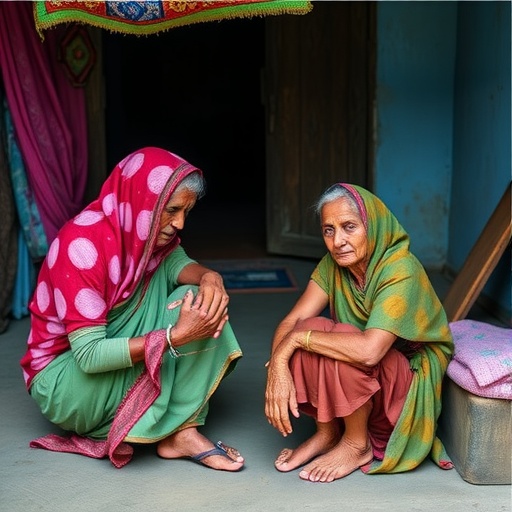In a groundbreaking study published in BMC Geriatrics, researchers, led by Mourougan et al., delve into the complex and often overlooked realm of healthcare utilization among older adults in rural Odisha, India. The significance of this research cannot be overstated, as it sheds light on the myriad factors that influence healthcare access and usage in a demographic that often faces numerous barriers. This investigation not only highlights the current state of elder healthcare in these regions but also serves as a critical reflection on healthcare systems that often fail to meet the needs of their most vulnerable populations.
The study encompasses a wide-ranging cross-sectional analysis of older adults residing in rural Odisha, a region marked by its unique cultural contexts and economic challenges. The researchers meticulously compiled data from a representative sample, utilizing structured questionnaires that garnered insightful responses regarding health status, frequency of healthcare visits, and various determinants of healthcare usage. Their findings provide a rich tapestry of insights into both the barriers these individuals face and the facilitators that promote better healthcare access.
Notably, the researchers identified a confluence of socio-economic factors that play a pivotal role in determining healthcare utilization patterns among older adults. Economic constraints, such as poverty and lack of health insurance, emerged as formidable barriers, severely limiting access to essential medical services. The study’s analysis revealed a direct correlation between income levels and healthcare usage, with wealthier older adults having greater access to healthcare resources compared to their impoverished counterparts.
In addition to economic factors, the study also investigated the impact of educational attainment on healthcare utilization. The findings indicated that older adults with higher levels of education were significantly more likely to seek medical attention when needed. This highlights a fundamental issue within rural communities where educational resources are often scarce, leading to a cycle of ignorance about health that adversely affects healthcare seeking behavior. The researchers emphasize the need for targeted educational interventions that can empower these individuals to seek the care they desperately need.
Another critical aspect examined in the study was the influence of social support networks on healthcare utilization. The presence of family and community support was shown to facilitate better access to medical care, suggesting that social capital plays an integral role in the healthcare-seeking behavior of older adults. The researchers propose that strengthening these social networks could significantly enhance healthcare access and utilization, potentially saving lives in these rural settings.
Furthermore, contextual elements such as the availability of healthcare facilities and their proximity to rural populations were analyzed. The results underscored a significant disparity in healthcare infrastructure, revealing that many older adults live far from hospitals or clinics, making regular visits impractical. The implications of this finding are profound, indicating a pressing need for policies aimed at improving healthcare accessibility in remote areas. The role of transportation was also scrutinized, highlighting that inadequate transportation options could further isolate older adults from necessary health services.
Mental health was an additional focus of the study, uncovering the often-ignored intersection between mental well-being and healthcare utilization. The researchers discovered that older adults struggling with mental health issues were less likely to seek help for physical ailments, which can exacerbate health conditions and ultimately lead to poorer outcomes. This revelation calls for an integrated healthcare approach that addresses both physical and mental health needs concurrently.
The researchers did not shy away from discussing the impact of cultural beliefs and practices on healthcare utilization. Traditional health systems remain deeply ingrained in rural communities, and many older adults may prefer seeking help from local healers rather than formal healthcare systems. This cultural dimension complicates the narrative of healthcare access in rural Odisha, necessitating a nuanced understanding and integration of traditional practices within modern healthcare frameworks to encourage utilization.
The findings of this study are not merely academic; they possess the potential to influence public health policy, healthcare delivery systems, and community programs. By addressing the identified barriers and promoting facilitators of healthcare utilization, stakeholders can work collaboratively to enhance the overall health and well-being of older adults in rural settings. The implications extend beyond Odisha, offering insights that could be applicable to similar contexts in other developing regions.
Moreover, Mourougan et al. advocate for a multi-faceted approach that brings together various sectors – health, education, and social services – to create a comprehensive support system for older adults. By fostering collaboration among these sectors, policymakers can devise strategies that effectively tackle the root causes of healthcare disparities and facilitate better access to services.
The relevance of this research is underscored by the steadily growing aging population in many regions around the globe. As societies grapple with the reality of an aging demographic, understanding healthcare utilization patterns becomes critical. This study serves as an important reminder of the need for adaptive policies that respond to the unique challenges faced by older adults, particularly those in resource-limited settings.
In conclusion, the study by Mourougan and colleagues offers invaluable insights into the patterns and determinants of healthcare utilization among older adults in rural Odisha. By elucidating the intricate web of factors that influence healthcare access, this research paves the way for targeted interventions that could transform the healthcare landscape for vulnerable populations. As stakeholders and policymakers consider the implications of these findings, the hope is that future initiatives will prioritize the health and well-being of older adults, ensuring that they receive the care they need and deserve.
The study ultimately serves as a clarion call to action, urging communities to listen to the voices of their elder populations. It is a testament to the importance of continuous research in the field of geriatrics, and how such research can guide effective public health policies that enhance the quality of life for older adults across diverse contexts. As we move forward, the attention must remain steadfast on the challenges faced by this demographic, ensuring that healthcare systems are not only resilient but also equitable.
Subject of Research: Patterns and determinants of healthcare utilization among older adults in rural Odisha, India.
Article Title: The patterns and determinants of healthcare utilisation of older adults in rural Odisha, India – a cross-sectional study.
Article References:
Mourougan, M., Singh, A.K., Mishra, A. et al. The patterns and determinants of healthcare utilisation of older adults in rural Odisha, India – a cross-sectional study.
BMC Geriatr 25, 966 (2025). https://doi.org/10.1186/s12877-025-06706-x
Image Credits: AI Generated
DOI: https://doi.org/10.1186/s12877-025-06706-x
Keywords: Older adults, healthcare utilization, rural health, socio-economic factors, cultural beliefs, public health policy, Odisha
Tags: access to healthcare for vulnerable populationsbarriers to healthcare for older adultscross-sectional study of elder healthdeterminants of healthcare usageelderly health in Odishageriatric healthcare challengeshealthcare patterns in rural populationshealthcare systems in rural areashealthcare utilization among seniorsOdisha elder healthcare researchrural healthcare access in Indiasocio-economic factors in healthcare





